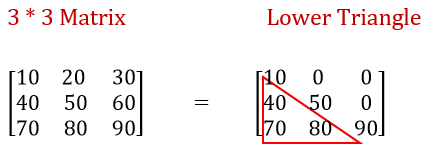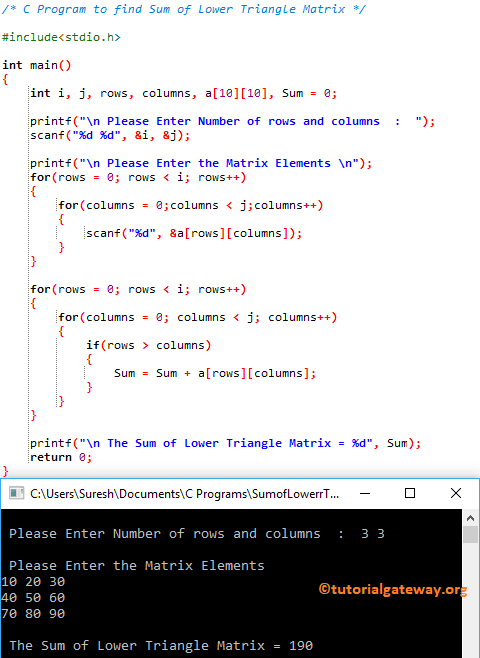How to write a C Program to find Sum of Lower Triangle Matrix with an example?. We already explained the lower triangle in our previous article.

C Program to find Sum of Lower Triangle Matrix Example
This program allows the user to enter the number of rows and columns of a Matrix. Next, we are going to find the sum of the Lower triangle of this matrix using For Loop.
#include<stdio.h>
int main()
{
int i, j, rows, columns, a[10][10], Sum = 0;
printf("\n Please Enter Number of rows and columns : ");
scanf("%d %d", &i, &j);
printf("\n Please Enter the Matrix Elements \n");
for(rows = 0; rows < i; rows++)
{
for(columns = 0;columns < j;columns++)
{
scanf("%d", &a[rows][columns]);
}
}
for(rows = 0; rows < i; rows++)
{
for(columns = 0; columns < j; columns++)
{
if(rows > columns)
{
Sum = Sum + a[rows][columns];
}
}
}
printf("\n The Sum of Lower Triangle Matrix = %d", Sum);
return 0;
}

In this C Program to find Sum of Lower Triangle Matrix, We declare single Two dimensional arrays Multiplication of size of 10 * 10. I suggest you refer to the Program to find the Lower Triangle Matrix article.
Below statements asks the User to enter the Matrix size (Number of rows and columns. For instance, 2 Rows, 2 Columns = a[2][2] )
printf("\n Please Enter Number of rows and columns : ");
scanf("%d %d", &i, &j);
Next, we used C Programming for loop to iterate each cell present in a[2][2] matrix. Conditions inside the for loops ((rows < i) and (columns < j)) will ensure the compiler not exceed the matrix limit. Otherwise, the matrix will overflow
The scanf statement inside the for loop and will store the user entered values in every individual array element such as a[0][0], a[0][1], …..
for(rows = 0; rows < i; rows++).
{
for(columns = 0; columns < j; columns++)
{
scanf("%d", &a[rows][columns]);
}
}
In the next program line, We have one more for loop to find the sum of the Lower Triangle of a Matrix
for(rows = 0; rows < i; rows++)
{
for(columns = 0; columns < j; columns++)
{
if(rows > columns)
{
Sum = Sum + a[rows][columns];
}
}
}
User inserted values for C Program to find Sum of Lower Triangle Matrix are: a[3][3] = {{10, 20, 30}, { 40, 50, 60},{70, 80, 90}}
Row First Iteration: for(rows = 0; rows < 3; 0++)
The condition (0 < 3) is True.
Column First Iteration: for(columns = 0; 0 < 3; 0++)
The condition (columns < 3) is True. So, it will start executing the statements inside the loop
if(rows > columns) => if(0 > 0) – This condition is False. So, it will exit from If statement
Column Second Iteration: for(columns = 1; 1 < 3; 1++)
The condition (columns < 3) is True.
if(rows > columns)=> if(0 > 1) -This condition is False.
Column Third Iteration: for(columns = 2; 2 < 3; 2++)
if(rows > columns)=> if(0 > 2) – condition is False.
Column Fourth Iteration: for(columns = 3; 3 < 3; 3++)
The condition (columns < 3) is False. So it will exit from the loop.
Next, row value will increment to 1.
Row Second Iteration: for(rows = 1; rows < 3; 1++)
The condition (1 < 3) is True.
Column First Iteration: for(columns = 0; 0 < 3; 0++)
The condition (columns < 3) is True. So, it will start executing the statements inside the loop
if(rows > columns) => if(1 > 0) – This condition is True.
Sum = Sum + a[rows][columns] => 0 + 40
Sum = 40
Column Second Iteration: for(columns = 1; 1 < 3; 1++)
The condition (columns < 3) is True.
if(rows > columns)=> if(1 > 1) – condition is False.
Column Third Iteration: for(columns = 2; 2 < 3; 2++)
if(rows > columns)=> if(1 > 2) – condition is False.
Column Fourth Iteration: for(columns = 3; 3 < 3; 3++)
The condition (columns < 3) is False. So it will exit from the loop.
Next, rows value will increment to 2.
Row Third Iteration: for(rows = 2; rows < 3; 2++)
The condition (2 < 3) is True.
Column First Iteration: for(columns = 0; 0 < 3; 0++)
The condition (columns < 3) is True. So, it will start executing the statements inside the loop
if(rows > columns) => if(2 > 0) – condition is True.
Sum = Sum + a[rows][columns] => 40 + 70
Sum = 110
Column Second Iteration: for(columns = 1; 1 < 3; 1++)
The condition (columns < 3) is True.
if(rows > columns)=> if(2 > 1) – This condition is True.
Sum = Sum + a[rows][columns] => 110 + 80
Sum = 190
Column Third Iteration: for(columns = 2; 2 < 3; 2++)
if(rows > columns)=> if(2 > 2) – This condition is False.
Column Fourth Iteration: for(columns = 3; 3 < 3; 3++)
The condition (columns < 3) is False. So it will exit from the loop.
Next, rows value will increment to 3. After the increment, the condition inside the first for loop (rows < 3) will fail. So it will exit from the loop.
